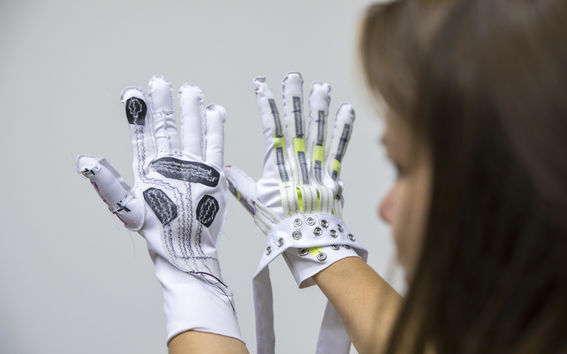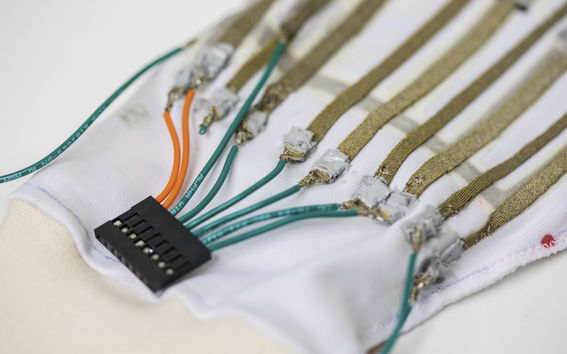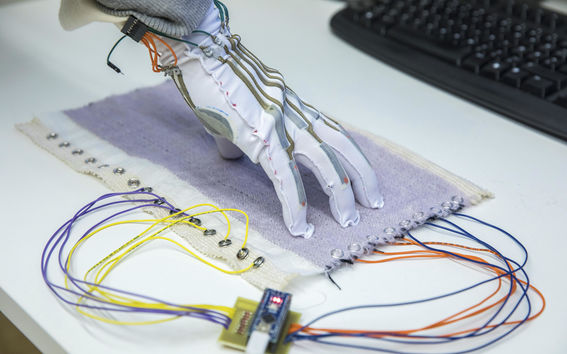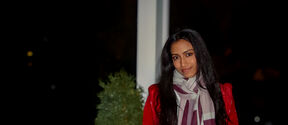Technology to guide rehabilitation patients by the hand

Symptoms begin suddenly in the middle of a workday – the right side of the body goes numb and speech becomes slurred. A cerebrovascular obstruction diagnosis is confirmed at the hospital. Beginning treatment quickly with blood thinners saves the patient’s life, but one side of the body refuses to obey commands.
Rehabilitation begins at once. The patient is supplied with a virtual rehabilitation programme designed specifically for them as well as tailored smart gloves. These guide the performing of exercises and monitor the progress of rehabilitation. This is one vision of how wearable technology could be used as an aid in health care. Professor Yu Xiao and her research group aim to make it a reality within a few years.
AI as designer
Professor Xiao heads Aalto University’s multidisciplinary Wearable Systems Lab, which develops systems that merge artificial intelligence and wearable technology. Wearable technology refers to devices that are used as textiles or accessories attached to the body.
In the wake of smart watches, virtual goggles and smart clothing, wearable tech is expected to grow into a business worth tens of billions in the near future. In addition to wellbeing and entertainment, this holds lots of promise for health care as well. Cutaneous or on-skin technology can provide real-time information about a patient’s health and the effectiveness of treatments, or guide a patient performing exercises – quite literally – by the hand.
The development work of Xiao’s research team aims to go further than just products or applications. In a just begun project, the researchers are developing an AI-based tool. With its help, health care providers can separately tailor an individual virtual rehabilitation programme for each patient.
‘The design tool only needs a picture or video of the patient’s hand as well as data on the rehabilitation plan. It can then automatically draft a template for manufacturing the individualised smart glove and train it with a tailor-made machine learning model,’ Xiao says.
Smart gloves can be used for virtual hand training exercises that improve range of motion and gripping ability as well as rehabilitate sufferers of tactile sense disorders. In order for the gloves to correctly measure even the slightest finger and hand movements, they must fit the patient’s hand precisely and have their sensors placed appropriately.
‘Manufacturing individualised smart gloves the traditional way is laborious, as you need to make prototypes, gather data and train machine learning models. With this design tool, it would be possible to have gloves in use in as little as a couple of days.’

Virtual rehabilitation provides feedback
Wearable technology can answer many practical needs in rehabilitation, says neurologist Kristina Laaksonen, who is a senior physician at Helsinki University Hospital’s intense neurorehabilitation ward. Laaksonen is involved with the project’s steering group.
‘Following a stroke, the brain is in an especially plastic state, making it imperative that rehabilitation begins without delay and exercises should be done for hours and hours each day. It is important that exercises are performed diligently in order for the patient to learn movement trajectories correctly. Virtual rehabilitation can motivate the patient to increase their amount of exercise and wearable tech provides feedback on whether the exercises are being done right,’ says Laaksonen.
Cerebrovascular disorders are a significant national health issue: some 25 000 cases of these disorders are diagnosed annually in Finland and morbidity has increased among the working age population. Effective rehabilitation can significantly promote recovery.
Working together with rehabilitation professionals and patients, Xiao’s team is developing VR games that used together with smart gloves can help patients develop their body control, muscles and motor skills. Laaksonen thinks a virtual environment can make exercises more meaningful for the patient, in addition to which it enables them to safely practise abilities needed in everyday life.
‘Home is without a doubt the best environment for rehabilitation. Virtual therapy can provide high-quality and effective rehabilitation at home.’

The development of the tool is being performed in collaboration with Helsinki University Hospital and Kuopio University Hospital health care professionals and patients. The team consists of artificial intelligence, design, virtual reality and electronics design specialists. The project has received Business Finland funding for developing the prototypes and preparing for commercialisation.
Adapting to the body in motion
The computer monitor is the most common interface for interaction between humans and technology, but wearable tech offers a new, more subtle way to connect with the digital world. In rehabilitation, this can have a psychological impact on the user,” says designer and smart textile specialist Emmi Pouta.
‘Smart clothing can also fade out the notion of medical measuring equipment.’
Pouta is working on a doctoral thesis in Xiao’s research group. As part of her thesis, she is researching how textiles could measure the body’s movements or provide tactile feedback with the aid of miniscule sensors, electrically conducive wires and electronic components.
‘The better the sensors and other components are integrated into the fabric, the less the tech will be seen and felt. Technology that adapts to the body’s movements is more comfortable to use and improves measuring results.’
Pouta’s background in design is useful also in the designing of a user-driven process. Patients and health care professionals are taking part in the development and testing of the rehabilitation system from the very beginning.
An extremely technical viewpoint is often the hallmark of developing smart textiles, Pouta says. The fact that, at Wearable System Lab, technology and design professionals are gathered under one roof is enormously beneficial.
‘The collaboration has been eye-opening. All team members have learned to identify possibilities also from outside their own speciality area.’
So far, we have only scratched the surface with respect to the possibilities of wearable tech. Yu Xiao says her group is constantly looking for cooperation opportunities with companies and public sector organisations.
‘We want our research to always stem from genuine problems. We’re breaching the divide between laboratory development and real life.’
Text: Annamari Tolonen
This article has been published in the Aalto University Magazine issue 27, October 2020.
Read more news

Meet Shaya Vosough, assistant professor of transportation engineering
Shaya Vosough seeks to understand our travel choices and how they are influenced.
Meet Sampsa Laakso, assistant professor of manufacturing processes and systems
Assistant Professor Sampsa Laakso is an expert of virtual manufacturing.
Start the year with new insights – apply for FITech's spring courses!
Deepen your knowledge with courses from Finnish universities of technology, designed to meet the demands of the working life and help deepen your expertise for free.






